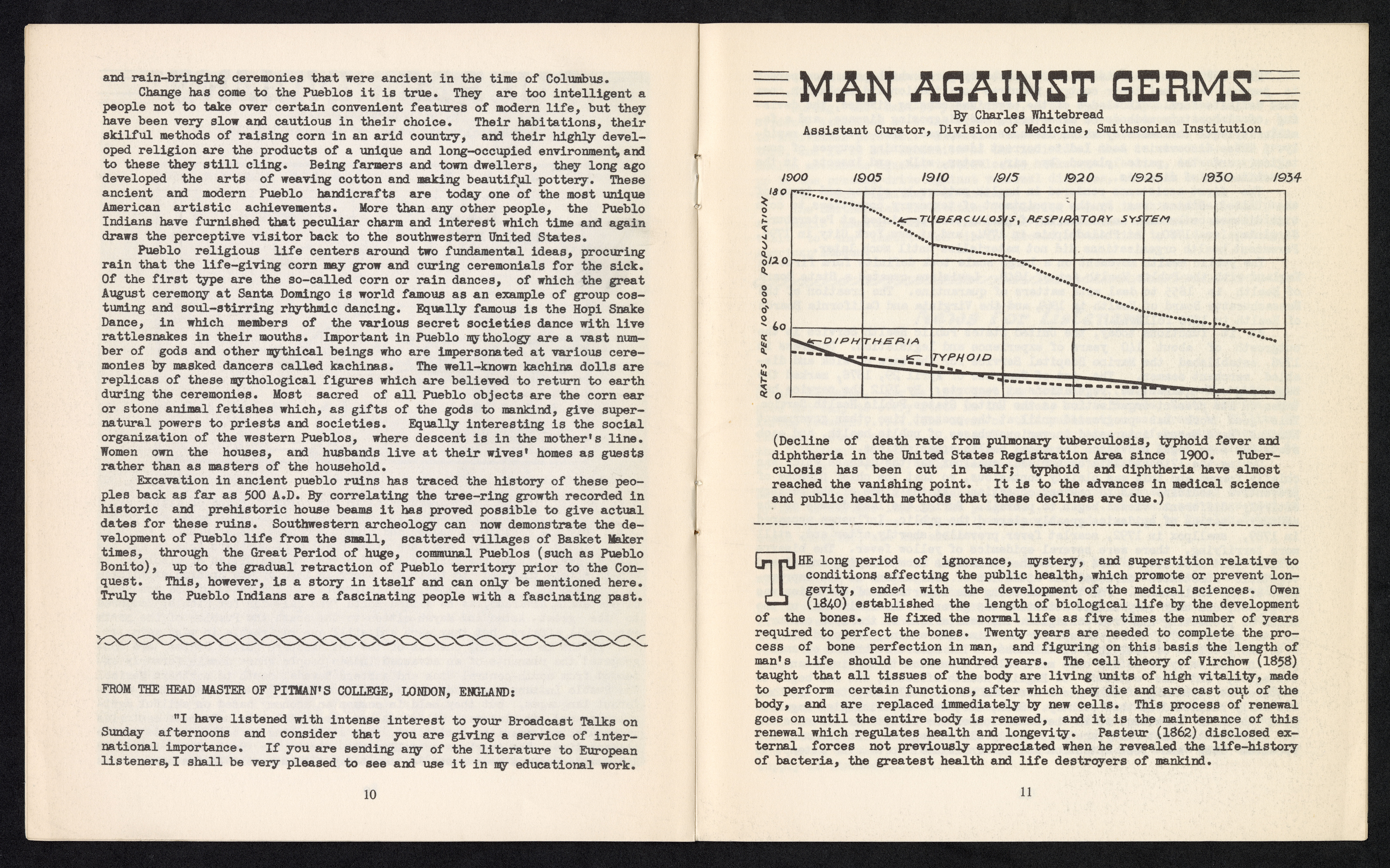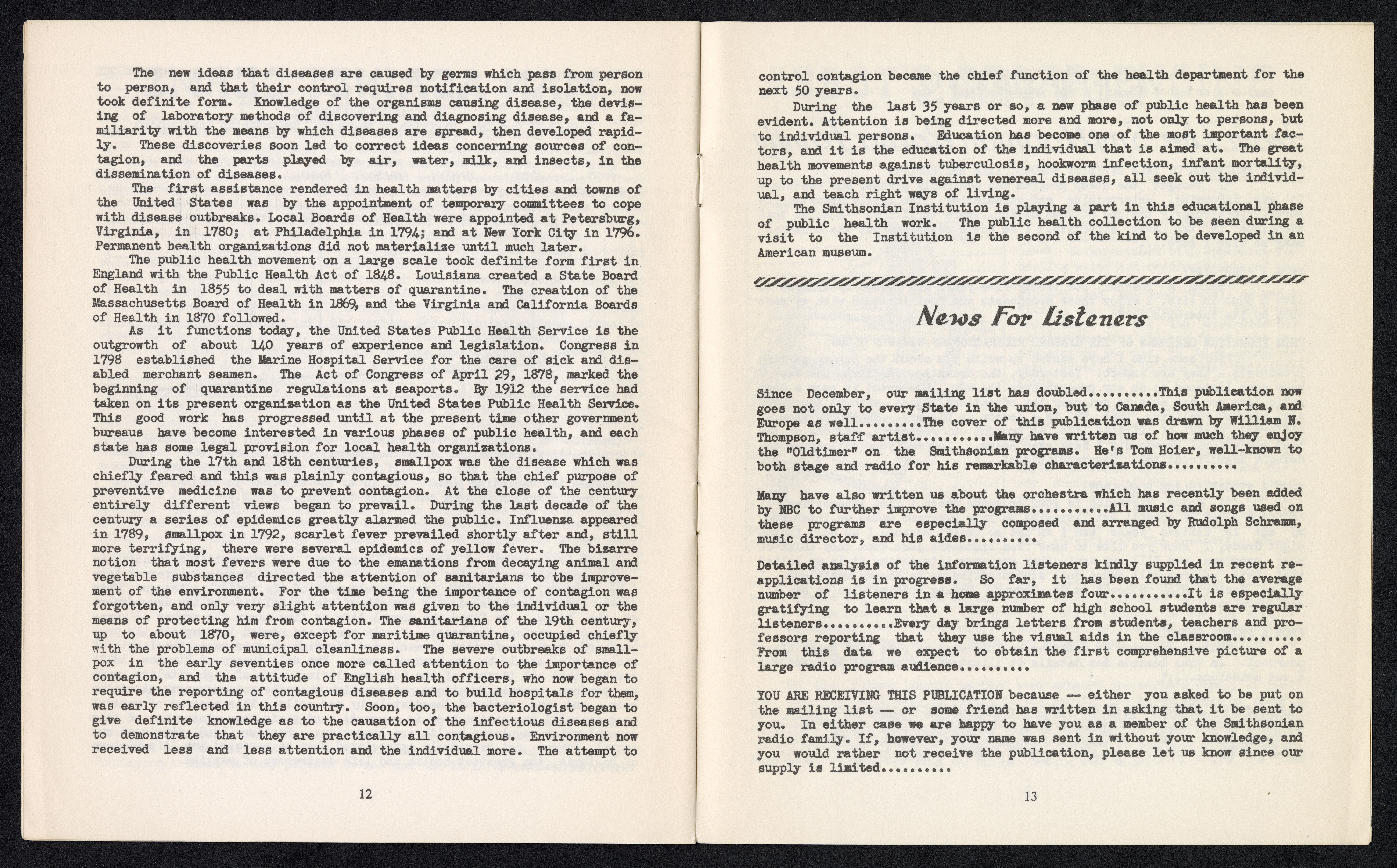In January 2020, I mentioned that the Archives sent 16” lacquer transcription discs and ¼” open reel audio tapes containing episodes of The World Is Yours, the Smithsonian’s first educational radio show, out to a vendor for digitization. Well they’re back, and after listening to the episodes for the first time, I can tell you they do not disappoint.

Given the current global situation, the episode titled “Man Against Germs” stuck out and immediately piqued my interest. What was the discussion surrounding germs like in the 1930s? The episode originally aired on March 28, 1937 and was centered around the public health exihibit at the United States National Museum (now the Arts and Industries building). It starts with “Old Timer,” the host, giving a brief overview on germs and how they can affect humans.

Listen to "Man Against Germs" — Brief Overview
[Woman] Good morning, Old Timer.
[Jim] Yes, good morning. How are you?
[Woman] You promised to tell us all about man’s fight against germs this morning.
[Jim] Man’s fight against germs? Well, that’s like saying man’s fight against the unseen.
[Old Timer] Well, at this very moment in this room, all about us are countless microscopic animals who would be delighted to get inside of us and strengthen themselves by weakening us.
[Woman] I remember once seeing some germs under a microscope. Tiny little beasts, they frighten me.
[Old Timer] Ah, it’s the fact that they can’t be seen that makes them so incidious.
[Jim] Yes, but, uh, how do they get in to our bodies?
[Old Timer] Well, first by penetration. If you cut yourself while shaving, many germs can have the time of their lives, and the result might be boils or ring worms.
[Woman] Oh, Jim, I’ve always told you to be careful when you shave.
[Jim] I’ll never shave again darling.
[Old Timer] Another way is to breathe them in. Germs jump at the chance of entering that way, causing tuberculosis, pneumonia, influenza.
[Jim] You can swallow them too, can’t you Old Timer?
[Old Timer] Yes, and if you’re not careful, you get a sore throat, and many stomach diseases.
[Woman] You certainly are a cheerful person, Old Timer. (laughs)
[Old Timer] Well, one has to face facts. There are germs in the air, eager to do their work. The more we are taught how to combat them, the more really cheerful we can be. Imagine had we lived in a time when people didn’t know there were such things as germs?
[Woman] How terrible. Always exposed to a danger they didn’t even know existed.
[Old Timer] Exactly.
Following the introduction, the episode moves on to the history of the scientifict study of germs, starting with a dramatization of the discovery of microbes by Antoni van Leeuwenhoek. Each time the episode jumps to the discovery of additional information about germs, the story is told through a reenactment of the event by voice actors. In the clip below, an actor playing Robert Koch describes finding groups of microbes isolated on different sections of a solid surface.
Listen to "Man Against Germs" — Microbes
[Old Timer] Well, up to 1860, the only way you could keep germs in a laboratory was in a liquid. That meant that in the same liquid might be five different kinds of germs, each causing a different disease. Consequently. Koch wanted to find some way in which you could separate one type of germ from another and study that particular one. One day in his laboratory, he saw something which…
[Robert Koch] Oh Karl.
[Karl] Yes Dr. Koch?
[Koch] Come over here to the table.
[Karl] Yes Dr. Koch.
[Koch] Amazing how a slice of boiled potato can change a man’s way of thinking.
[Karl] Why, I don’t understand sir. What do you mean?
[Koch] Take this slice of boiled potato for instance.
[Karl] Yes.
[Koch] It’s been lying on my table for quite a while. I paid no attention to it. Now I’ll put it under the microscope and you tell me what you see.
[Karl] Why the left side, sir, seems to be filled with microbes of the same kind.
[Koch] Now look down a bit to the right, yes.
[Karl] Why these microbes are different, aren’t they?
[Koch] Yes my boy. Each class of microbe seems to prefer a different spot on the potato. All the microbes of Class A stick together on the right and all the microbes of Class B stick together on the left. That makes it very easy, don’t you think?
[Karl] Why of course, sir, you mean that
[Koch] Yes, that’s the very clue I’ve been looking for. A solid foundation for microbes, not a liquid. Then we can corral each herd of microbes like we do cows in a pasture.
In addition to the audio, the Smithsonian produced a booklet for each month of broadcasts that included further information on the topic. Usually, any charts or photographs included in the booklet were referenced within the recording so that listeners could follow along with a visual . The section on the “Man Against Germs” episode contained a chart showing the decline in deaths from tuberculosis, typhoid fever and diptheria. It also provided readers with information on the Smithsonian’s efforts to educate its audiences on public health topics.
I can’t wait to dive in to more of these audio recordings! Stay tuned for more sneak peeks as my adventure through this material continues.
Related Collections
- Smithsonian Institution Sound Recordings, circa 1915-1941, Accession 05-142, Smithsonian Institution Archives
- Smithsonian Institution, Editorial and Publications Division, Records, 1847-1966, Record Unit 83, Smithsonian Institution Archives
Related Resources
- Preserving “The World Is Yours,” by Kira Sobers, The Bigger Picture, Smithsonian Institution Archives
Produced by the Smithsonian Institution Archives. For copyright questions, please see the Terms of Use.



Leave a Comment